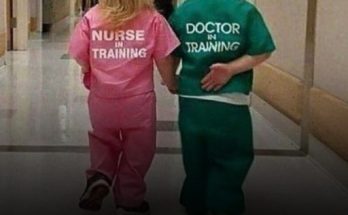Have you ever found yourself staring at an image, convinced there’s something hidden that you just can’t see? Well, here’s a chance to put your visual skills to the test! Only those with 10/10 vision—or what we might call “eagle eyes”—can spot where the second eagle is hiding in this challenging puzzle.

This visual challenge is not just about spotting things quickly; it’s about patience, concentration, and a sharp eye for detail. In a world where we are constantly moving from one task to the next, taking the time to really observe something can be a rare but rewarding experience. If you’re ready to push your observational skills to the limit, then this is the perfect puzzle for you. Are you confident you have what it takes to solve it?
What Is This Challenge About?
The challenge is simple in concept but tricky in practice: there are two eagles hidden in the image, but only a few people can easily find both. Many people see one eagle immediately, but the second one often remains elusive. It’s a true test of your visual acuity, focus, and patience. In fact, spotting the second eagle can be as challenging as finding a needle in a haystack.
Some people are naturally good at these visual puzzles, spotting hidden images almost immediately. If you think you have great vision and sharp attention to detail, this is your opportunity to prove it! This puzzle is not just fun but also an excellent way to exercise your brain.
Why Are Visual Puzzles Important?
Visual puzzles like this one serve more than just entertainment purposes; they also help keep your brain sharp and enhance your cognitive abilities. When you work on puzzles that challenge your perception and attention, you’re actually improving the way your brain processes information. Visual puzzles help increase concentration, train your eyes to pick up on small details, and sharpen your overall mental focus.
Engaging in these types of activities can boost your observational skills in real-life situations as well. For example, the ability to notice fine details can be useful in many aspects of daily life, from driving and reading body language to finding lost items. Puzzles like this not only entertain but also train your brain to become more attentive and efficient in processing visual information.
Can You Spot It?
Now, let’s get down to the challenge. The image you’re about to see has two eagles, but most people only see one right away. The second eagle is camouflaged, blending into its surroundings so well that it seems almost invisible. If you’re able to find both, you can truly say you have the eyes of an eagle. But don’t worry if you can’t see it right away; sometimes it takes a few moments to adjust your focus and find what you’re looking for.
Take a deep breath, relax, and let your eyes move across the image slowly. Look for shapes that might resemble parts of an eagle—such as the beak, wings, or feathers. It’s all about changing your perspective and looking beyond the obvious.

The Joy of the Hunt
There’s something genuinely satisfying about solving a puzzle like this one. Whether it takes you seconds or minutes, the thrill of finally seeing what others may have missed is incredibly rewarding. It’s that “Aha!” moment, the instant when everything clicks and the hidden eagle suddenly pops out of the scene. That’s when you know your focus has paid off.
These moments of realization don’t just make you feel good—they’re also very good for your brain. Studies have shown that engaging in puzzles, brain teasers, and visual challenges can improve memory, enhance creativity, and keep your mind agile. Plus, it’s just plain fun!
Hints to Help You Out
If you’re having trouble spotting the second eagle, here are a few tips that might help. First, try squinting your eyes or viewing the image from a different angle. Sometimes changing your perspective helps hidden details come into focus. Also, look at the background—often, the second eagle is hiding in a spot you wouldn’t expect, blending in with the scenery.
Another helpful trick is to look for symmetry. Eagles have distinct shapes, and symmetry can often reveal their hidden forms. Train your eyes to pick out patterns and shapes that might resemble the eagle, even if they seem to blend in with the rest of the scene.
The Answer
If you still can’t find the second eagle, don’t feel discouraged. This kind of visual puzzle is meant to be challenging, and it can take time for your brain to adjust and notice the hidden image. The satisfaction comes from the process of searching and the moment when it finally clicks.
Take your time, and remember that the goal isn’t just about finding the answer but also about enjoying the process of looking. If you do eventually spot the second eagle, congratulate yourself—you’ve accomplished what many people cannot!
The Benefits of Visual Challenges
Incorporating visual puzzles like this one into your routine can have long-term benefits for your mental health. Visual puzzles are a great way to break from the usual tasks and give your brain a different kind of workout. They promote relaxation, reduce stress, and can even improve mood. There’s something meditative about sitting down and focusing intently on something fun and challenging.
Visual puzzles also encourage you to be patient. In a time where everything is instant—from social media to fast food—it’s nice to have an activity that requires a little extra time and concentration. It’s a reminder that sometimes, the most rewarding things come from a bit of effort and perseverance.
Conclusion: Test Your Eagle Eyes
The “10/10 eyes” challenge is more than just a fun exercise—it’s a way to hone your observational skills, engage in a bit of healthy mental exercise, and take a break from the constant rush of daily life. Whether you manage to spot the second eagle in seconds or it takes a while, the important part is that you challenged yourself and enjoyed the process.
So, do you think you have the eyes of an eagle? Whether or not you find the second eagle, know that you’ve given your brain a workout and sharpened your focus. Challenges like this one remind us that there’s value in looking at things closely, appreciating the details, and enjoying the hunt for something hidden. The answer might be at the end, but the journey of getting there is what makes it all worth it.



